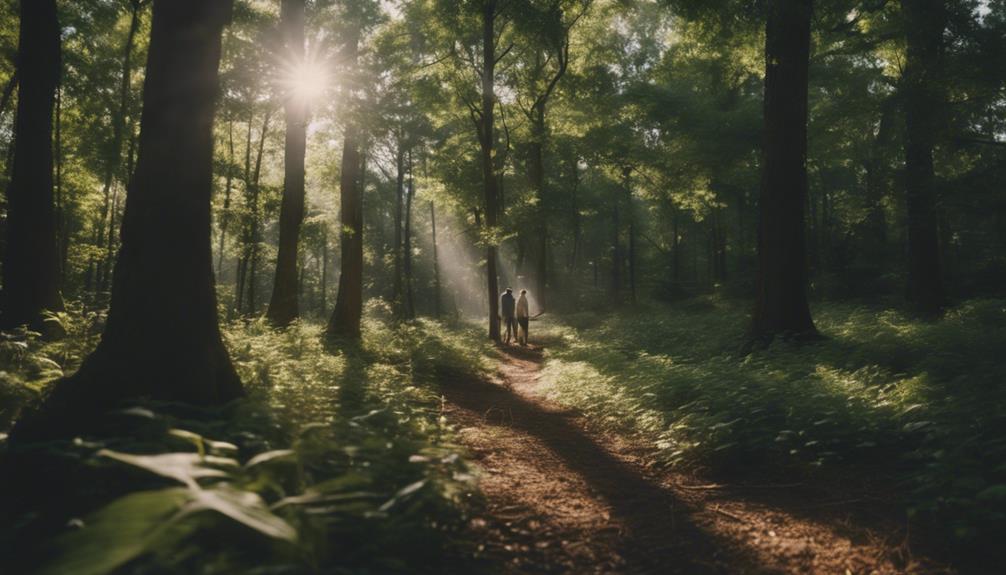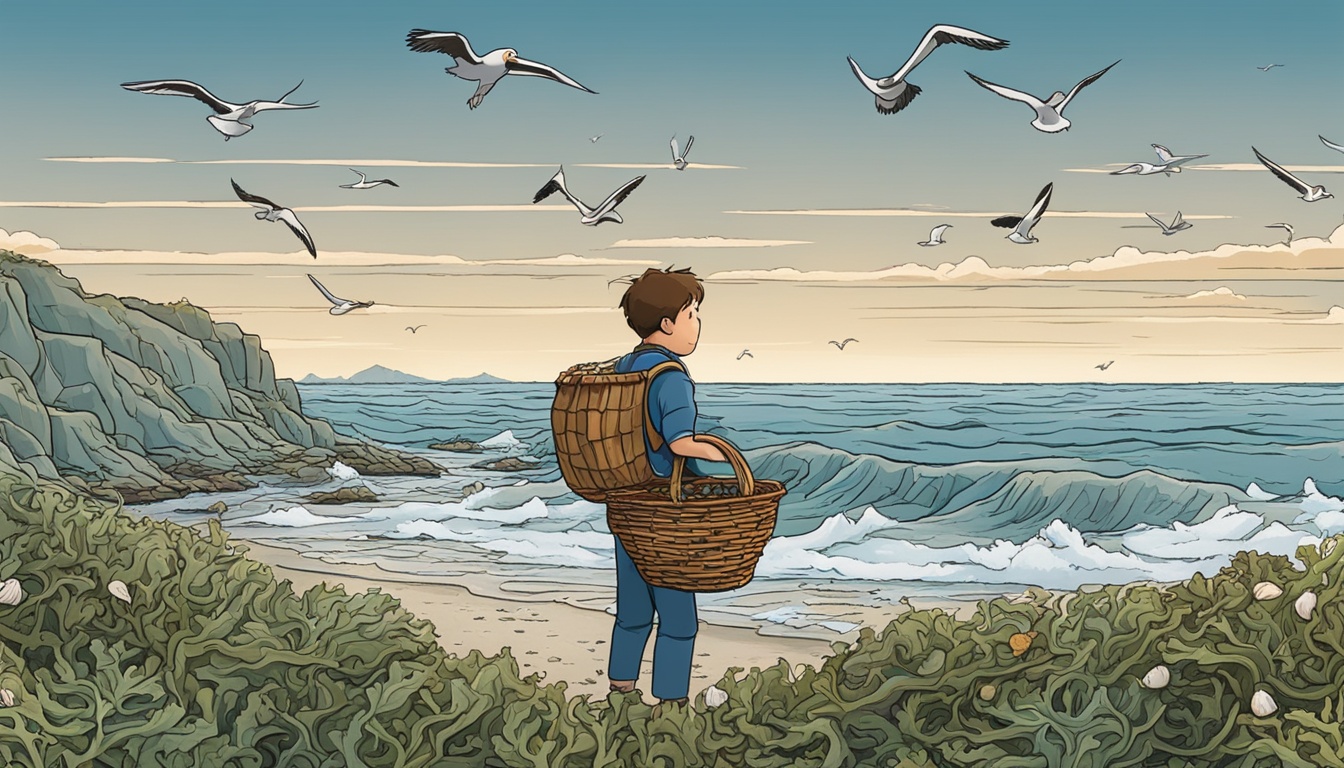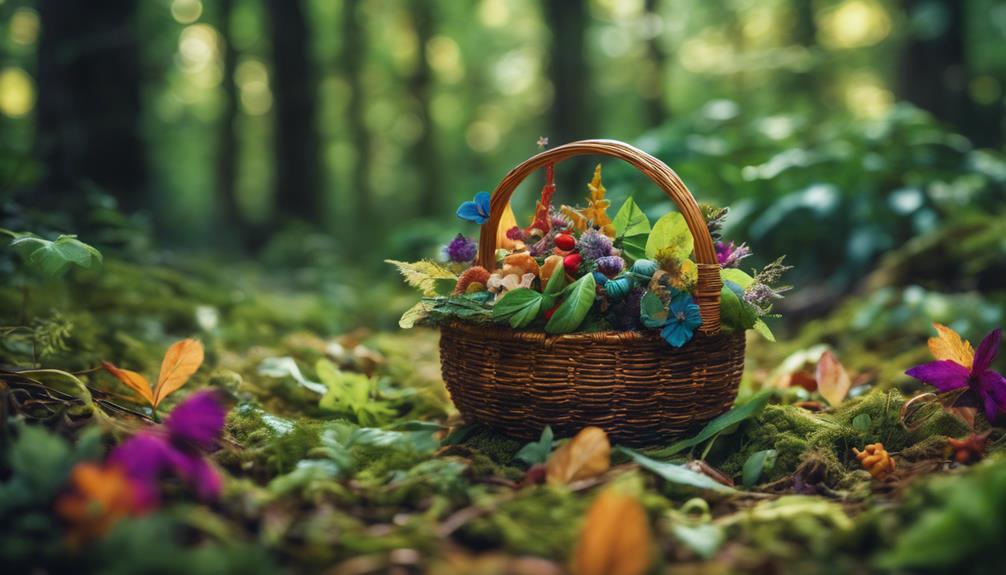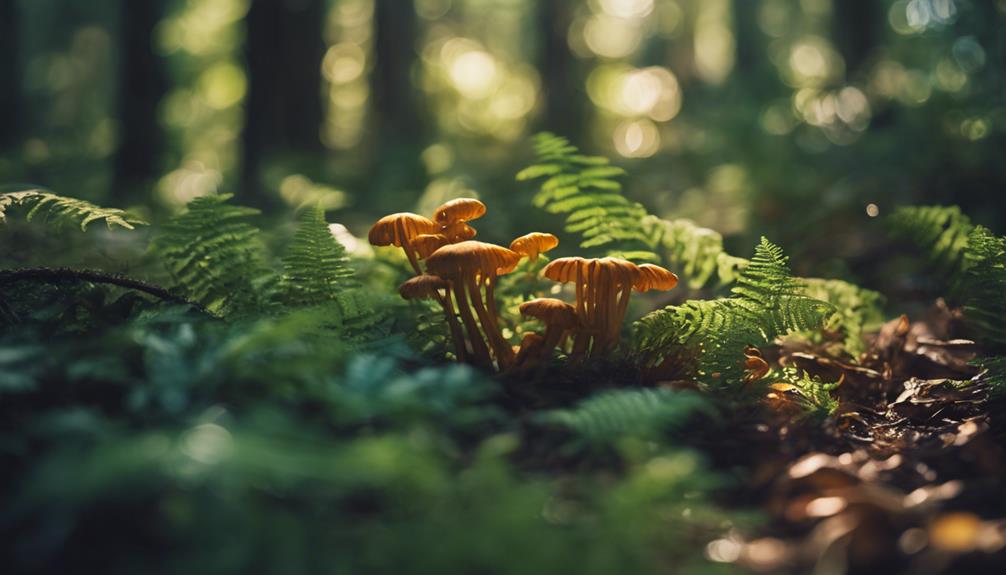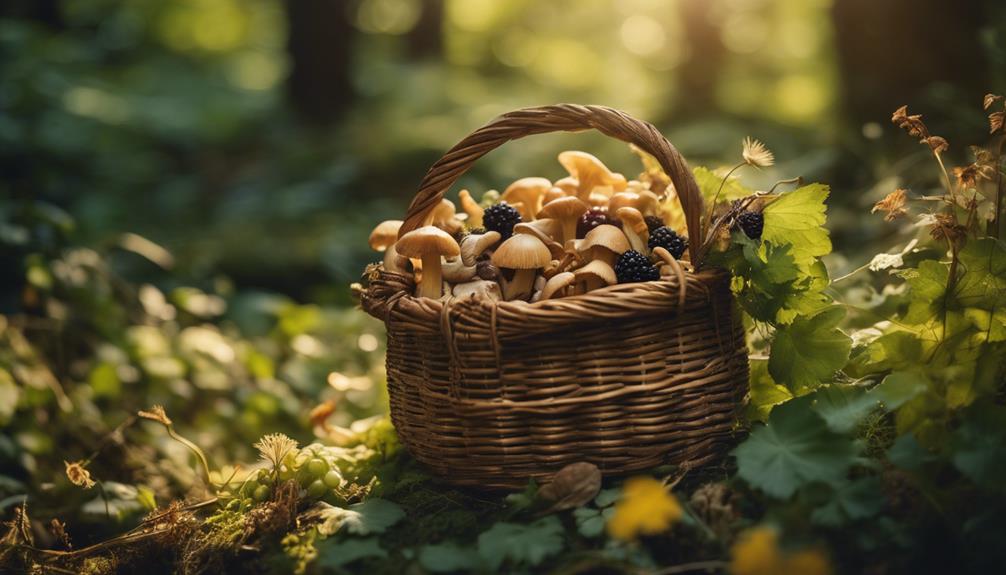You're about to discover the rich flavors and cultural significance of Georgia's edible landscapes, where muscadine grapes, black walnuts, and wild berries await your foraging skills. Like Native Americans and early settlers, you can tap into the state's diverse terrain to uncover hidden treasures. From raspberries to elderberries, and from herbal remedies to culinary delights, Georgia's wilderness is full of surprises. As you explore these edible landscapes, you'll uncover a world of nutrients, antioxidants, and healing properties. Continue on this journey to uncover the secrets of foraging like a native in Georgia.
Key Takeaways
- Familiarize yourself with local plant species, laws, and regulations to forage safely and responsibly in Georgia's edible landscapes.
- Develop proper identification skills to avoid toxic plants and ensure a safe foraging experience.
- Respect private property, practice sustainable harvesting, and obtain permission when necessary to maintain ecological balance.
- Incorporate native edibles like muscadine grapes, black walnuts, and wild berries into your diet to boost nutrition and support local biodiversity.
- Learn about Georgia's cultural heritage and historical uses of wild edibles to deepen your connection with the natural environment.
Wild Edibles & Medicinal Plants
As you venture into Georgia's wilderness, you'll discover a treasure trove of wild edibles and medicinal plants that have been used for centuries by Native Americans and early settlers.
Georgia's diverse landscape offers a wide range of wild edibles, from fruits like muscadine grapes to nuts like black walnuts. These native edible plants have been a staple in the diets of Georgia's indigenous communities for centuries, providing essential nutrients and flavors to their cuisine.
You'll also find medicinal plants like the Cherokee Rose, which has been used to treat various ailments. As you explore Georgia's edible landscapes, you'll uncover the rich history and cultural significance of these wild edibles and medicinal plants.
Native Edible Plants in Georgia

As you explore Georgia's edible landscapes, you'll discover a variety of native plants that aren't only delicious but also nutritious.
You'll want to get familiar with the common wild edibles that grow in the region, including fruits like huckleberries and elderberries, as well as nuts like hickory and pecan.
Wild Edibles to Know
You'll find a diverse array of wild edibles in Georgia, from sun-loving shrubs and trees like blueberries and plums to native herbs like beebalm and mountain mint. As you explore the state's edible landscapes, you'll discover a wealth of wild edibles waiting to be foraged.
Native plants like raspberries, strawberries, and elderberries are ripe for the picking, offering a sweet and tangy taste of Georgia's natural beauty.
Beyond fruits, Georgia's wild edibles also include a variety of nuts from hickory, pecan, oak, walnut, butternut, American hazelnut, and chestnut trees. These nuts provide a crunchy and nutritious snack, perfect for munching on the go.
Additionally, you'll find an assortment of roots and tubers, as well as herbs like wild bergamot, violets, and mountain mint, adding depth and variety to your foraging experience. With such a diverse range of wild edibles, Georgia offers a foraging adventure like no other, enriching your experience with local flavors and nutrients.
Common Foraged Plants
Among the most sought-after native edible plants in Georgia, blueberries, huckleberries, raspberries, strawberries, elderberries, and plums top the list of common foraged plants, offering a diverse range of flavors and textures for foragers to discover.
You'll find that these Wild Edibles thrive in various conditions, with blueberries and huckleberries loving the sun, while raspberries and blackberries prefer full sun. Elderberries, on the other hand, enjoy full sun, and plums are adaptable to both full and part sun environments.
As you explore Georgia's edible landscapes, you'll also stumble upon an array of nuts from native trees, including hickory, pecan, oak, walnut, butternut, American hazelnut, and chestnuts.
Don't forget to forage for herbs like beebalm, wild bergamot, onions, mountain mint, and violets, which add to the rich flavor palette of Georgia Native Plants.
And, if you're looking for something more substantial, edible roots and tubers like groundnut and wild sweet potato are waiting to be discovered.
Foraging Basics in Georgia

Before you start foraging in Georgia, familiarize yourself with the local plant species that grow wild, from sweet wild strawberries to tangy persimmons, to guarantee a safe and successful harvest.
You'll want to explore Georgia's diverse range of native edibles, but first, understand the foraging laws that govern the state's edible landscapes. Respectful foraging practices are essential, so make sure you're aware of the regulations that protect both the environment and private landowners.
You shouldn't forage on private property without permission, and always follow sustainable harvesting practices to conserve Georgia's natural resources. Proper identification skills are vital, as some plants can be toxic or cause allergic reactions. Don't risk your health; take the time to learn about the plants you plan to forage.
Nutritional and Medicinal Benefits

As you explore Georgia's edible landscapes, you'll discover a treasure trove of wild edibles packed with nutrients, antioxidants, and amino acids that can supercharge your diet.
Additionally, you'll uncover medicinal plants with healing properties that can help alleviate various ailments, from soothing digestive issues to calming skin irritations.
Wild Edibles Nutrition
You'll be surprised by the wealth of nutrients and medicinal benefits hidden in Georgia's wild edibles, which offer a diverse range of essential vitamins, minerals, and antioxidants.
By incorporating these wild edibles into your diet, you can reap the rewards of improved health and well-being.
For instance, edible plants like muscadine grapes and wild berries provide anti-inflammatory and antioxidant properties, while foraged plants like wild onions and pawpaws contain valuable nutrients like fiber, vitamins, and minerals.
These nutrients can boost your immune function, improve digestion, and support overall health.
Traditional uses of native plants like persimmons and black walnuts highlight their historical significance in providing both nutrition and medicinal benefits.
By foraging for wild edibles, you can tap into these natural health benefits and experience the positive impact on your overall well-being.
Medicinal Plant Properties
By venturing into Georgia's wild, you'll uncover a treasure trove of medicinal plants boasting an impressive array of nutritional and medicinal benefits. As you forage like a native, you'll discover that many of these plants have been used for centuries to promote holistic health and wellness.
Native plants like muscadine grapes and black walnuts, for instance, have historical medicinal uses that are still revered today. By understanding the properties of these medicinal plants, you'll gain a deeper appreciation for Georgia's edible landscapes and the opportunities they provide for traditional healing practices.
As you incorporate these plants into your foraging practices, you'll be promoting a more natural approach to health and wellness. By doing so, you'll be tapping into the rich cultural heritage of Georgia's native communities, who've long relied on these plants for their medicinal properties.
Culinary Uses of Native Edibles

Incorporating native edibles into your cooking repertoire not only adds a touch of Georgia's cultural heritage to your dishes but also injects a burst of fresh flavors and textures into your culinary creations.
By using wild plants like muscadine grapes, Cherokee Rose, and black walnuts, you'll be tapping into the rich cultural significance of these native species.
Persimmons and wild onions, staples for Native American tribes and early settlers, can add a new dimension to your recipes.
The diversity and richness of Georgia's cuisine are enhanced by the culinary uses of native wild berries, flavorful greens, and aromatic herbs.
Imagine crafting recipes that showcase the unique flavors and textures of these native plants.
Exploring the culinary applications of native edibles not only provides delicious dishes but also promotes sustainable foraging practices and appreciation for the local ecosystem.
As you experiment with these ingredients, you'll be contributing to the preservation of Georgia's edible heritage.
Gardening With Native Edibles

As you explore the culinary uses of native edibles, consider taking your connection with Georgia's edible landscapes to the next level by incorporating these plants into your gardening practices. By doing so, you'll not only enhance your gardening experience but also promote sustainable practices and support local ecosystems.
Here are some benefits of gardening with native edibles:
- Diverse flavors: Incorporate muscadine grapes, black walnuts, and wild onions into your garden to explore traditional flavors and connect with Georgia's culinary heritage.
- Biodiversity boost: Native edibles support local ecosystems and promote biodiversity, making your garden a haven for local wildlife.
- Conservation efforts: By using native plants, you'll reduce the need for pesticides, fertilizers, and irrigation, supporting conservation efforts and preserving Georgia's natural beauty.
- Deepened connection: Gardening with native edibles allows you to connect with the land, appreciate Georgia's natural bounty, and foster a deeper appreciation for the state's edible landscapes.
Wildlife Benefits and Biodiversity

You'll be amazed at how foraging like a native in Georgia can have a profound impact on the local ecosystem, supporting a diverse range of wildlife and promoting biodiversity in the process. By embracing native foraging practices, you'll be contributing to the preservation of Georgia's natural habitats and the diverse wildlife populations that call them home.
| Benefits of Native Foraging | Wildlife Benefits |
|---|---|
| Preserves natural habitats | Supports diverse wildlife populations |
| Maintains ecosystem balance | Fosters healthy environment for wildlife |
| Enhances biodiversity | Promotes coexistence with wildlife |
| Supports local ecosystems | Encourages sustainable practices |
| Preserves edible wild species | Preserves Georgia's natural heritage |
As you explore Georgia's edible landscapes, remember that your actions have a direct impact on the local ecosystem. By foraging like a native, you'll not only enjoy the benefits of edible wild species but also contribute to the preservation of Georgia's natural beauty. So, get out there and start foraging – the local wildlife will thank you!
Conservation and Ethical Considerations

When foraging in Georgia's edible landscapes, it's important to embrace conservation practices and ethical considerations that safeguard the long-term health of natural habitats and the diverse species that inhabit them. As you venture into the Wild, remember that responsible foraging is key to preserving the balance of nature.
Here are some essential guidelines to keep in mind:
- Always obtain permission before foraging on private property to avoid trespassing and respect landowners' rights.
- Avoid overharvesting native plants, ensuring their survival for future generations.
- Follow local regulations and guidelines to prevent harm to the environment and its inhabitants.
- Educate others about the importance of ethical foraging practices, promoting a culture of responsibility and respect for Georgia's edible landscapes.
Frequently Asked Questions
How Do You Forage Wild Edibles?
You forage wild edibles by identifying native plants, understanding seasonal availability and habitats, and mastering proper identification skills to avoid toxic look-alikes, then harvesting sustainably and preparing your finds with traditional and modern methods. Foraging edible plants in South Carolina requires familiarity with the region’s unique ecosystems, such as coastal marshes, pine forests, and wetlands, where diverse wild edibles flourish year-round. Knowledge of local laws and ethical harvesting guidelines ensures that you respect the environment while collecting responsibly. With these skills, you can enjoy a bounty of wild greens, berries, mushrooms, and more, connecting deeply with nature as you nourish yourself.
What Edible Berries Grow in Georgia?
As you wander through Georgia's lush landscapes, you'll stumble upon a treasure trove of juicy secrets, and you'll discover that you can savor sweet treats like blueberries, raspberries, elderberries, and strawberries, all ripe for the picking!
What Is the Wild Food in Georgia?
You'll discover Georgia's wild food scene offers a plethora of options, including nuts like hickory and pecans, fruits like persimmons and elderberries, and herbs like beebalm and wild bergamot, waiting to be foraged and savored!
Where Is the Best Place to Forage Plants?
You'll find the best spots to forage in forests, meadows, wetlands, and riverbanks, away from pollution and pesticides. Head to public parks, nature reserves, or private lands with permission for a safe and ethical forage.
Conclusion
As you set out on your foraging journey, remember that Georgia's edible landscapes are a treasure trove of flavors, nutrients, and medicinal wonders. Like a master chef, Mother Nature has carefully crafted a recipe for wellness, and it's up to you to harvest the ingredients.
So, go ahead, take a bite out of the wild, and savor the flavors of the Peach State's hidden gems!

